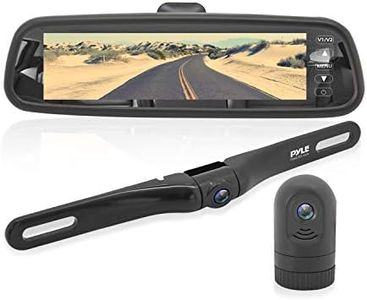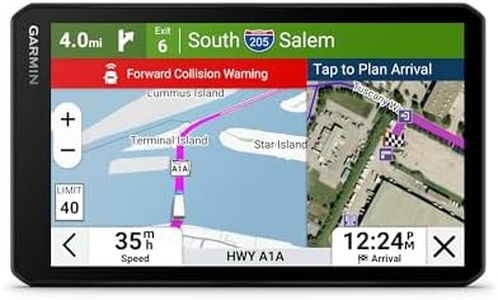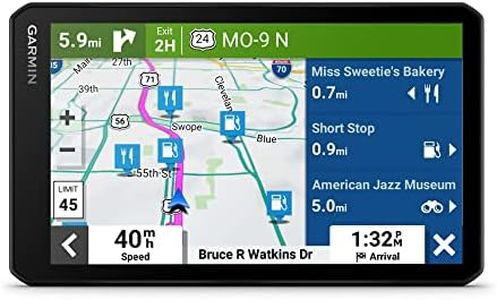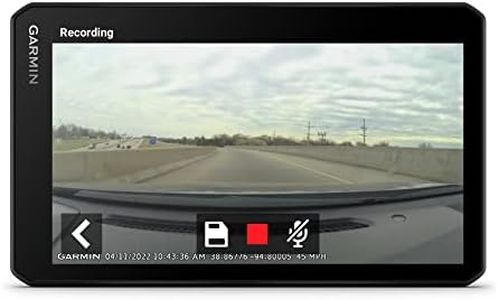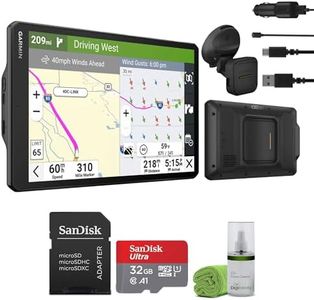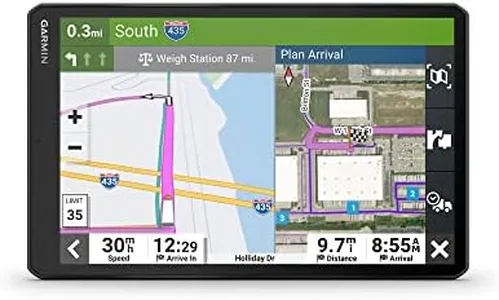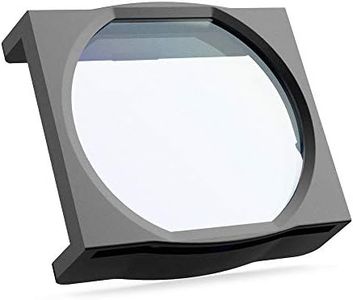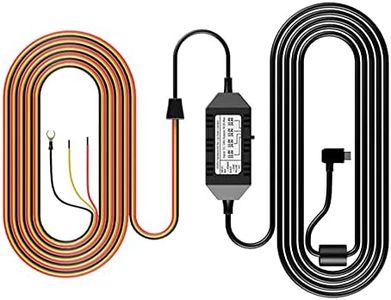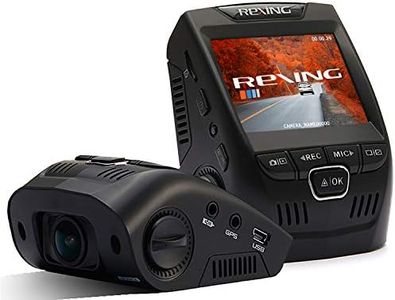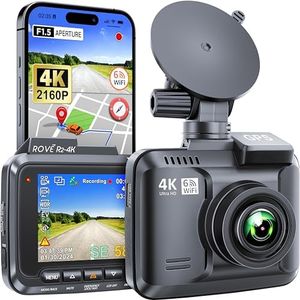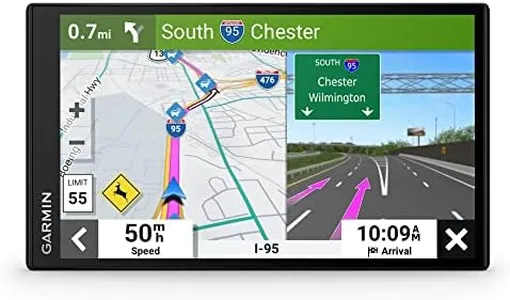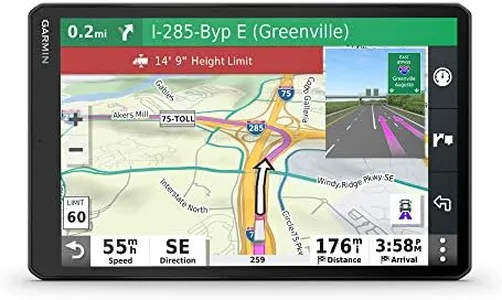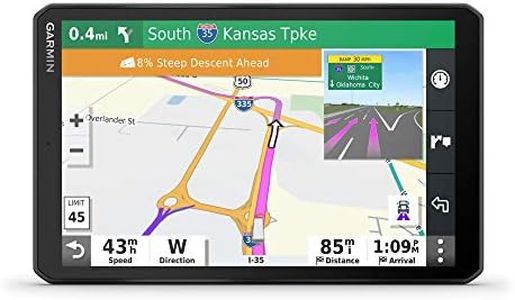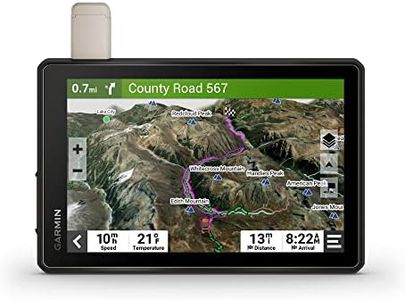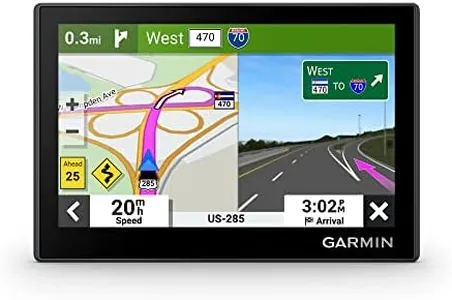10 Best Garmin Automotive GPS Devices 2025 in the United States
Our technology thoroughly searches through the online shopping world, reviewing hundreds of sites. We then process and analyze this information, updating in real-time to bring you the latest top-rated products. This way, you always get the best and most current options available.

Our Top Picks
Winner
Garmin dēzlCam™ OTR725 High-Res 7” GPS Truck Navigator with Built-in 1080P HD Dash Cam, Automatic Incident Recording, Custom Routing, Satellite Imagery, Wind Speed, Community-Shared Loading Docks
Most important from
303 reviews
The Garmin dēzlCam OTR725 is designed specifically for truck drivers, combining a sharp 7-inch high-resolution touchscreen with a built-in 1080p HD dash cam. This combo helps drivers not only navigate but also record their trips, which can be valuable for safety and incident proof. The device offers custom truck routing that considers the size and weight of your vehicle, helping avoid low bridges and tight turns, though these routes may not cover every area perfectly. It includes useful map overlays like wind speed warnings and satellite imagery for better arrival planning.
Truck-related Points of Interest (POI) such as truck parking, loading docks, and CAT Scale locations are integrated, making it easier to find relevant services on the road. The device also supports traffic updates, PrePass weigh station notifications, and has a directory of truck and trailer services searchable by amenities, which benefits long-haul drivers. Voice control functions primarily when paired with the dēzl app on a smartphone. Battery life is not the focus, so the device is intended to be mounted and powered within the vehicle. Mounting options are standard for in-cab use, with the large screen ensuring visibility while driving.
Some features require pairing with a smartphone and an active app subscription, which may add complexity for drivers wanting a standalone GPS. Additionally, the dash cam's legality varies by location, so users should verify local regulations. This device is well suited for truck drivers seeking an all-in-one navigator and dash cam featuring trucking-specific routes and community features, though full functionality depends on external apps.
Most important from
303 reviews
Garmin DriveCam™ 76, Large, Easy-to-Read 7” GPS car Navigator, Built-in Dash Cam, Automatic Incident Detection, High-Resolution Birdseye Satellite Imagery
Most important from
2945 reviews
The Garmin DriveCam™ 76 is a feature-rich automotive GPS device with a large, easy-to-read 7-inch high-resolution screen, making it highly user-friendly for drivers. One of its standout features is the built-in dash cam, which provides automatic incident detection and saves video clips to a secure online vault for easy access and sharing through the Garmin Drive app. However, users should be aware of the legal restrictions regarding dash cam usage in certain areas.
The device offers comprehensive map coverage across North America, including the U.S., Mexico, Canada, and several other regions, ensuring reliable navigation in these areas. Real-time traffic updates, fuel prices, weather, and smart notifications are accessible when paired with a compatible smartphone, enhancing the driving experience. Voice control via Garmin Voice Assist and hands-free calling, when connected to a smartphone via Bluetooth, add to the convenience and safety of the device. The inclusion of forward collision and lane departure warnings, along with alerts for school zones and sharp curves, promote safer driving.
Additionally, the GPS comes with a directory of U.S. national parks, TripAdvisor traveler ratings, and millions of Foursquare points of interest, making it ideal for road trips and exploring new destinations. The built-in Wi-Fi connectivity allows for easy map and software updates without needing a computer. Some of the drawbacks include the limited mention of battery life and the dependence on a smartphone for several connected features, which might not suit users who prefer a standalone device. The Garmin DriveCam™ 76 is best suited for drivers looking for an all-in-one navigation and safety solution with advanced features and comprehensive map coverage.
Most important from
2945 reviews
Garmin RV Cam 795, Large, Easy-to-Read 7” GPS RV Navigator, Built-in Dash Cam, Automatic Incident Detection, Custom RV Routing, High-Resolution Birdseye Satellite Imagery
Most important from
770 reviews
The Garmin RV Cam 795 is tailored for RV enthusiasts, featuring a sizeable 7-inch screen that is easy to read, making navigation straightforward. The device covers a wide range of maps, including the U.S., Mexico, Canada, Puerto Rico, U.S. Virgin Islands, Cayman Islands, and Bahamas, ensuring extensive North American coverage. Custom RV routing is a standout feature, allowing for route optimization based on your vehicle's size and weight; however, this may not always account for every road condition, so always double-check posted signs and conditions.
The built-in dash cam provides added safety by recording your travels, although its legality may vary by location. Safety features such as forward collision and lane departure warnings, along with alerts for school zones and sharp curves, enhance the driving experience. Preloaded directories of RV parks and services, along with millions of POIs from platforms like Foursquare, make it easy to locate essential stops and interesting spots.
The device supports hands-free calling through smartphone pairing and offers voice control, adding convenience. Birdseye Satellite Imagery offers high-resolution aerial views, aiding in smoother arrivals at RV parks or campgrounds. One notable limitation is the lack of built-in traffic updates, which means you'll need a smartphone for real-time traffic information. Mounting options include a vehicle suction cup mount, making installation straightforward. In summary, the Garmin RV Cam 795 excels in providing RV-specific navigation and safety features, making it a valuable tool for RV travelers, with a few considerations regarding traffic updates and custom routing limitations.
Most important from
770 reviews
Buying Guide for the Best Garmin Automotive GPS Devices
When choosing a Garmin automotive GPS device, it's important to consider several key specifications to ensure you get the best fit for your needs. A GPS device can make your driving experience more convenient and stress-free by providing accurate navigation, real-time traffic updates, and other useful features. Understanding these specifications will help you make an informed decision and select a device that meets your specific requirements.FAQ
Most Popular Categories Right Now
